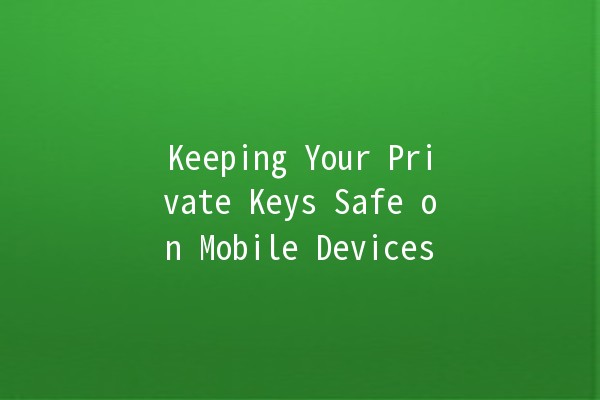
As cryptocurrency becomes increasingly popular, the importance of securing private keys cannot be overstated. Given that more and more users are accessing digital wallets directly from their smartphones, knowing how to keep these keys safe on mobile devices is paramount. Failing to secure your private keys could lead to significant financial losses, as unauthorized access can result in the theft of your digital assets. This article explores effective strategies to protect your private keys while using mobile devices, ensuring your hardearned cryptocurrency remains under your control.
Understanding Private Keys
Before diving into security tips, it’s vital to understand what private keys are. A private key is a cryptographic key that allows you to access and manage your cryptocurrency. Think of it like a password; whoever has the private key has control over the associated funds. Loss or theft of a private key means losing access to your cryptocurrency, often irreversibly.
Practical Techniques for Enhancing Mobile Security
Here are five specific techniques you can apply to safeguard your private keys on mobile devices:
Overview: Hardware wallets are physical devices designed to securely store your private keys offline.
Implementation:
Purchase a reputable hardware wallet, such as a Ledger or Trezor device.

Set up the hardware wallet by following the manufacturer's instructions. This usually involves creating a secure PIN code and backing up your recovery phrase.
Only connect your hardware wallet to your mobile device when you need to make transactions. Keeping it disconnected reduces the risk of hacking and malware exposure.
Example: If you wish to transfer a part of your cryptocurrency holdings, connect the hardware wallet to your mobile wallet app only for the transaction. Afterward, disconnect it to maintain security.
Overview: Use mobile wallet applications that offer encryption and strong security protocols.
Implementation:
Research and select a wallet application with strong security features, such as endtoend encryption, twofactor authentication (2FA), and biometric access (fingerprint or facial recognition).
Ensure the wallet allows you to create a complex password and backup your wallet securely.
Example: Popular wallets like Exodus or Trust Wallet incorporate encryption and can back up your private keys automatically. Regularly update the wallet app to patch any security vulnerabilities.
Overview: 2FA provides an extra layer of security beyond just a password.
Implementation:
Use an authenticator app like Google Authenticator or Authy to generate timesensitive codes for logging into your wallet or exchanges.
In case your mobile device is lost or stolen, enable recovery methods that allow easy transfer of your 2FA settings securely.
Example: When attempting to log into your wallet app, a code will be sent to your authenticator app. You must enter this code along with your password, enhancing protection.
Overview: Regularly updating your mobile device’s firmware can strengthen its security against potential vulnerabilities.
Implementation:
Check for software updates periodically. Most mobile operating systems have an option to download updates automatically; ensure this is enabled.
Update the wallet applications used for your cryptocurrency, as these updates often contain important security fixes.
Example: If a security update for your Android or iOS device is pending, promptly install it. This minimizes the chances of malicious software exploiting known vulnerabilities.
Overview: Phishing is a common method scammers use to gain access to your private keys.
Implementation:
Always verify the authenticity of links, especially those received via emails or social media platforms. Look for official websites and avoid clicking on suspicious links.
Educate yourself about common phishing techniques, including fake wallet apps or misleading messages that request sensitive information.
Example: If you receive an email claiming to be from your wallet provider with a link to verify your account, do not click it. Instead, visit the official website directly through your browser to check your account status securely.
Frequently Asked Questions
Losing your private key usually means losing access to your cryptocurrency. Without the key, there’s no way to recover your assets. Hence, always back up your keys in a secure manner, like writing them down in a safe place.
While you can use public WiFi, it poses significant security risks. It's better to use a secured personal network. If you must use public WiFi, employ a Virtual Private Network (VPN) to encrypt your connection.
Change your wallet password regularly, ideally every few months or immediately after a security incident. Ensure the new password is strong and unique to prevent unauthorized access.
Some wellregarded mobile wallet apps include Exodus, Trust Wallet, and Electrum. Each has unique features; select one that fits your needs while ensuring it emphasizes security.
Recovery typically involves using your backup seed phrase. When setting up a wallet, you’ll receive this phrase; store it securely. If you lose the device, you can install the wallet app on another device and import your wallet using the seed phrase.
If you suspect that your wallet is compromised, immediately transfer your funds to a new wallet with a different private key. Change passwords and 2FA settings for your accounts related to the wallet.
By following these practical techniques and remaining vigilant, you can enhance the security of your private keys on your mobile device. Understanding the potential risks and implementing these strategies will go a long way in protecting your digital assets and providing peace of mind in your cryptocurrency journey.

